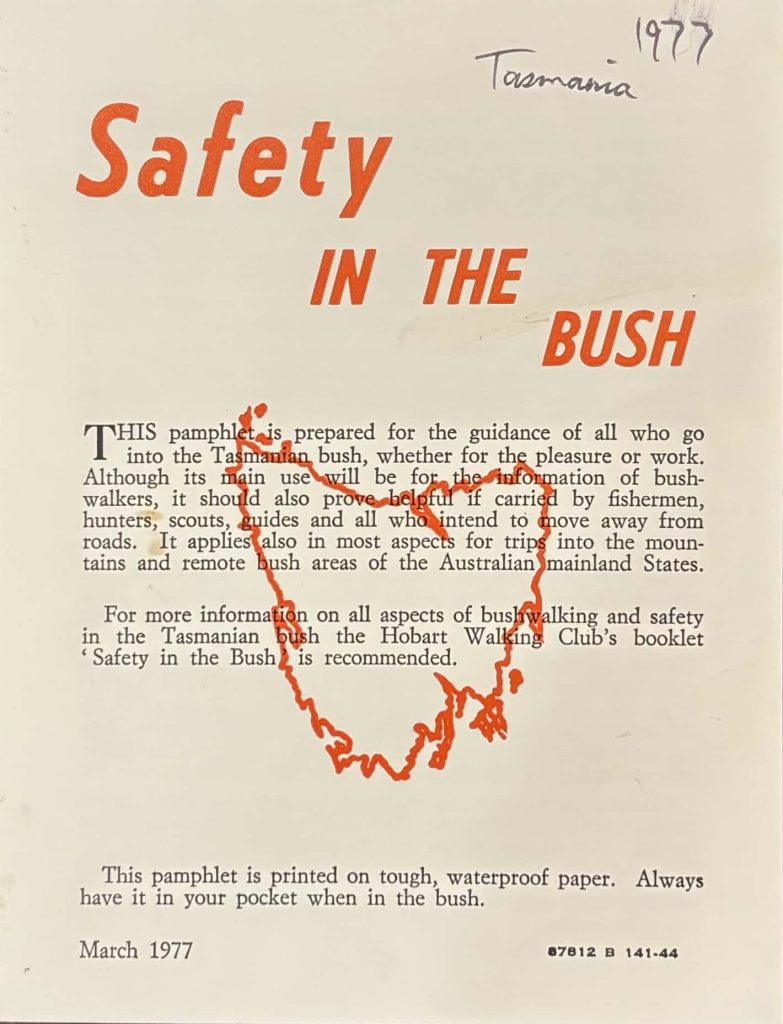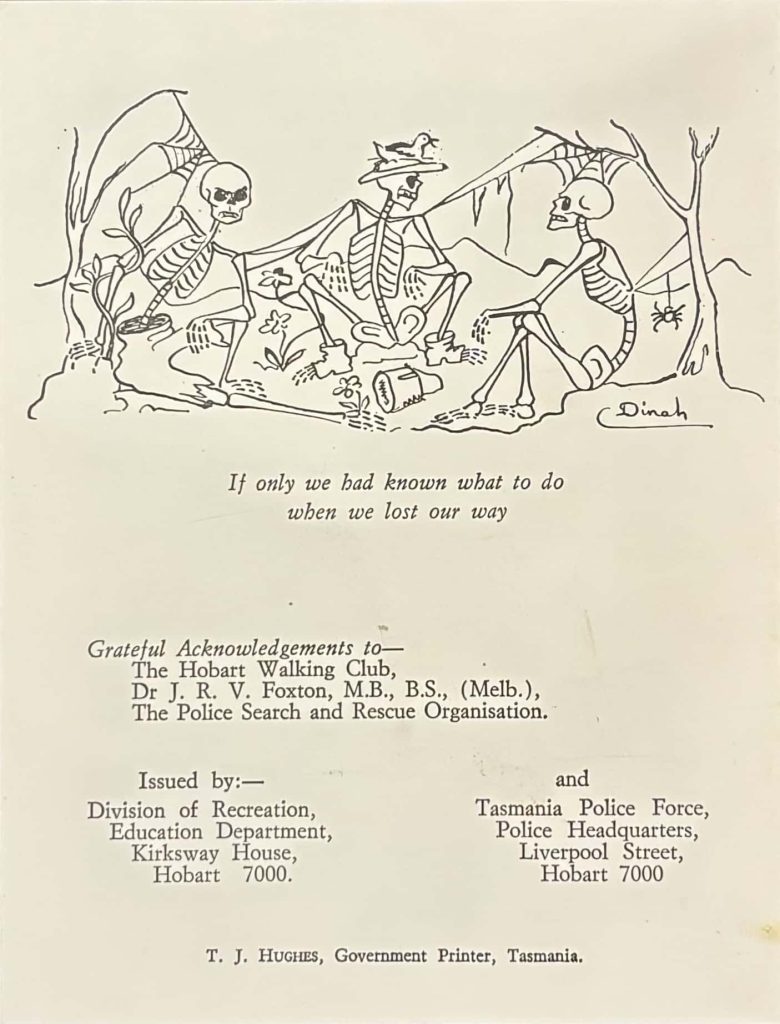From the Archive: a pamphlet produced in 1977 shows just how little has changed.

See the end for suggested 2024 updates.
PREPARATION FOR THE TRIP
- Plan your route beforehand and obtain intormation from experienced walkers or people who are familiar with the area.
- Do not undertake too much within the time available and recognise your limitations in relation to the country to be covered.
- Obtain the best maps and always carry a compass. Learn how to use both of them. Don’t underestimate your walking time. Allow for terrain and delays.
- A party of four is a reasonable minimum for a party of average strength in rough country. This number allows one or two members of the party to go for help in the event of an accident. This possibility must always be borne in mind. Avoid going alone into wild country.
- Before leaving, always give details of your route to parents or friends and be certain that they are aware of the functions and telephone numbers of the Police Search and Rescue Organisation. These may be obtained from your nearest Police Station. Leave the route details written down because memories are often unreliable when an emergency arises.
- For all trips into remote areas register details of your party and your trip with the Police at their city headquarters or at the police station nearest to the departure point. This will enable the Police Search and Rescue Organisation to help you more effectively if assistance is needed. Bushwalking parties from the mainland should always follow this routine.
- Before starting any trip in a national park that has a ranger discuss your plans with him when entering and report out when leaving. Accept any advice that he may give.
- ALWAYS REPORT YOUR RETURN – to the Police, if you registered with them or to the people who were given your trip information.
- Check the worthiness of your gear. Wear strong boots. Prepare your food list, allow 1 – 11/2 kg of food per day. Always include a surplus for emergencies.
- Never undertake a trip without long trousers in your kit. Blizzards and snow can occur in Tasmanian high country with startling suddenness even in summer. Have sufficient and suitable clothing for warmth and changing. The Tasmanian bush is notoriously wet, and first-class rain protection is essential. A completely waterproof coat, about three-quarter length and with a hood, is the best.
- Each member of a party should always carry on his person:— (1) a compass; (2) matches in a waterproof container; (3) a whistle; (4) a small notebook and pencil; (5) a knife or other sharp instrument. This emergency kit may save your life.
- All Tasmanian snakes are venomous. Treat for snakebite immediately. Carry a first-aid kit.
- Elect a leader who will be capable of taking control in an emergency.
WHILST ON THE TRIP
- The pace of the party should be regulated to suit every member, and the leader should not strain weaker members with a fast pace over rough country. Rest periodically.
- Every member of the party should take an intelligent interest in the route and should note physical features such as creeks and ridges. Look back regularly so that you may recognize the route in case it is necessary to retrace your steps. Don’t leave it to the leader to do this as it may be you who becomes lost – not him.
- Always try to be aware of progress and direction by frequent reference to map and compass or position of the sun.
- The party should be kept together at all times, and a strong experienced person should be stationed at the rear to keep up stragglers. Check numbers fairly frequently, particularly when there is a river crossing, before resuming after a rest and before and after a difficult section of country.
- Never leave your pack anywhere without making absolutely sure that you can find it again. Leave it in an open space and mark its position conspicuously. When making planned side trips, every member of the party should check that he carries on his person his own emergency kit. A waterproof coat and a sweater should also always be carried, no matter how fine the weather may appear to be.
- Be careful with your fires. A fire on peaty soil may go underground and burn out your camp whilst you are away.
- When you are ready to move on, be sure your fire is out – RIGHT OUT. Burn combustible rubbish. To avoid litter in the bush carry out the unburnable and uncorrodible part of the rubbish for disposal in the home rubbish bin.
IF YOU CAN CARRY IT IN, YOU CAN CARRY IT OUT.
- Regard all streams in flood as dangerous. Wait for them so down rather than attempt a risky crossing.
- If you get wet-don’t worry, save your dry clothes to sleep in at night— and put your wet ones on next morning. Never use your dry sleeping clothes for daytime wear.
- Whilst on the move don’t drink stagnant or impure water. BOIL DOUBTFUL WATER FOR AT LEAST 3 MINUTES, and always boil water in sheep country because of parasitic diseases.
SURVIVAL IN BLIZZARDS AND AVOIDING DEATH FROM EXPOSURE
Tasmania’s mountain areas are prone to sudden changes in weather conditions, and the danger of death trom exposure is an ever-present hazard. The victim of exhaustion and exposure can pass with startling suddenness from a state of consciousness to unconsciousness and death.
THERE IS LITTLE IF ANY WARNING OF THE APPROACH OF A CONDITION OF UTMOST DANGER when a party is out in snow, sleet or heavy rain with a cold gale blowing and clothes wet through.
Be aware of the conditions which may build up to a state of great danger. These may be listed as:-Insufficient clothing to retain body warmth; exposure to strong cold winds; getting wet; fatigue; lack of readily digestible food; shock following an accident; drinking alcoholic stimulant.
ACTION FOR SURVIVAL
The signs of severe exhaustion which could lead to death from exposure are:-Loss of muscular power; staggering; mental and physical lethargy; speech becoming slurred. As soon as any of these signs of exhaustion become apparent the whole party must immediately pitch tents and put the victim into the warmth of a sleeping bag in a tent before the body loses its ability to keep itself warm. To continue moving to try and reach a hut may result in death within sight of shelter or even after reaching it if the victim’s body temperature has dropped too low.
IT IS ESSENTIAL TO CARRY SLEEPING BAGS AND TENTS when going into high mountain country. Special care must be exercised when the party is large and of uneven stamina.
IF YOU GET LOST
- Sit down for a while and overcome the natural tendency to panic. He who panics will probably perish. When you’ve calmed yourself, plan as logically as you can. By using your map and recollection of the country traversed, decide which is the best route to safety.
- Check your food supplies and ration them if necessary.
- From the time you are uncertain of your location, mark the route taken by breaking green twigs, scratching arrows, placing stones on logs, making footprints in mud, dropping pieces of paper. Leave a dated note at each camp or fire site, indicating the direction you are going next, and the names and physical condition of the party.
- It is not safe to travel in rough bush country at night. Light a good fire in the best available sheltered position well before darkness overtakes you, and wait the arrival of daylight or searchers.
- Watch the weather closely. Do not march in blizzard, snow or fog – stay put, make as sheltered a camp as possible and get a fire going betore you are exhausted.
- If you are bewildered and cannot find your way to safety, find a sheltered campsite with water and with an open area nearby to facilitate signalling to aircraft, then stay put. A smoky fire will always attract the attention of searchers in aircraft or on the ground.
- The accepted distress signal is three signals together, regularly spaced. These may be given by smoke, i.e., blanketing a smoky fire, or by shouts, shots, whistles, flashing of mirror or torch, or by distinctive waving of cloth. The chief characteristic of these signals must be their regularity.

Tasmanian Bush Safety In 2024
This pamphlet is impressive in its thoroughness, and can only be faulted for failing to predict the future. Here are some suggested updates:
- Sweaters have been superseded by high quality fleeces and down jackets
- An emergency space blanket is a lightweight and useful safety item
- Water treatment is now a lot easier with purifying tablets, iodine or filters
- Satellite messengers or PLBs should now be carried on remote walks (I have omitted a large section on the correct symbols to be used for passing aircraft!)
- Tasmanian Parks & Wildlife Service staff should also be consulted on the latest track conditions
- Log books encountered en route should be completed with dates and intentions
And judging by the recent release of a backpack-sized Starlink Mini, for better or worse we will soon have internet too. What do you think? Leave your thoughts in the comments below.

Comments (0)